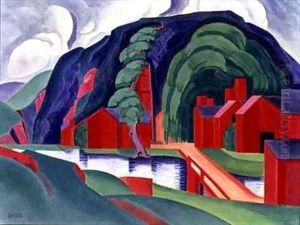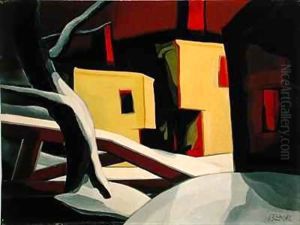Oscar Blumner Paintings
Oscar Bluemner, born Friedrich Julius Oskar Blumner on June 21, 1867, in Prenzlau, Germany, was a German-American painter who played a significant role in the development of American modernism, particularly known for his vibrant landscapes and cityscapes. Bluemner immigrated to the United States in 1892, initially pursuing a career in architecture before dedicating himself to painting. His architectural background profoundly influenced his artistic vision, imbuing his compositions with a strong structural foundation and a keen sense of form and color.
In the early 20th century, Bluemner's work began to evolve towards a more expressive use of color and abstraction, reflecting the influence of key movements in modern art, including Cubism and Futurism, as well as the work of contemporaries like Wassily Kandinsky. He was closely associated with Alfred Stieglitz, the influential photographer and art promoter, and his New York gallery, 291, where Bluemner exhibited his works alongside other avant-garde artists.
Despite his innovative contributions to American art, Bluemner struggled with financial difficulties and lack of recognition throughout much of his life. His work was critically celebrated in several exhibitions, yet commercial success eluded him, leading to periods of profound personal and financial hardship. Nevertheless, Bluemner continued to develop his distinctive style, characterized by bold, emotive color palettes, and simplified, almost abstract, representations of the landscape and urban environments.
Bluemner's later years were marked by isolation and depression, exacerbated by the death of his wife and his ongoing struggles with financial instability. On January 12, 1938, Bluemner died by suicide in Braintree, Massachusetts. Despite the tragic end to his life, Oscar Bluemner's legacy has grown posthumously, with his work now recognized as a vital contribution to American Modernism, celebrated for its pioneering use of color and abstraction in depicting the American landscape. His paintings are held in major collections and museums across the United States, including the Metropolitan Museum of Art and the Whitney Museum of American Art.

